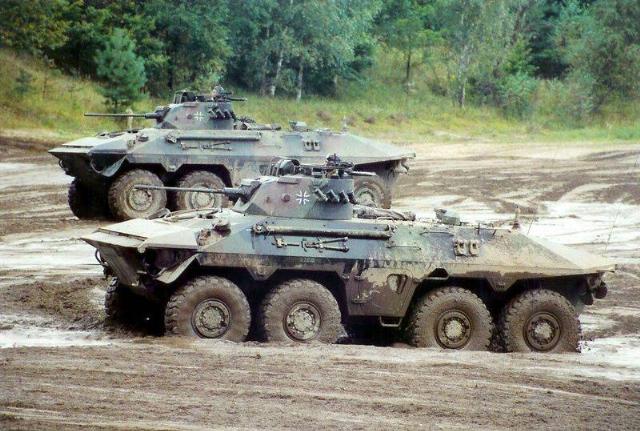The German online publication Hartpunkt, in the material by Waldemar Geiger "Deutsches Heer plant offenbar die Aufstellung von panzerstarken"Kampfaufklärungsbrigaden" ("The German Army, apparently, plans to create tank "combat reconnaissance brigades"), reports that as part of the new NATO defense plans, the Federal Republic of Germany promised the alliance to create a large number of new military units including, apparently, two so-called "Kampfaufklärungsbrigaden" ("combat reconnaissance brigades"). This was confirmed to the publication by well-informed sources.

Wheeled combat reconnaissance vehicles SpPz 2 Luchs, previously in service with the reconnaissance units of the German Army (c) Bundeswehr
According to available data, such a combat reconnaissance brigade, being a corps subordinate formation, will be called upon, in addition to performing traditional reconnaissance tasks, to also provide flank cover at the corps level and be deployed as a corps reserve. To accomplish these tasks, the German army is apparently considering equipping these brigades not only with extensive UAV capabilities (both for reconnaissance and for strike operations), but also with military equipment, including main tanks.
However, the German Army has not directly confirmed any plans to create such brigades. "Please understand that we cannot fundamentally confirm or deny individual points from the secret, recently approved NATO force plan," a representative of the German army said in response to a request from Hartpunkt.
The mention of secrecy is surprising, given that the location of the Bundeswehr units and formations is published by the Bundeswehr itself, both by type, number and location. For example, the deployment of the 45th Tank Brigade in Lithuania has recently received widespread coverage.
In connection with a letter from the outgoing Inspector (Commander) of the German Ground Forces to the Inspector General (Commander-in-Chief) of the Bundeswehr, recently published by the Reuters news agency, in which the latter insists on the need to increase the size of the German army from the current 62,000 to about 150,000 troops in order to fulfill the new NATO defense plans, the real reason for the evasive response seems to be The problem lies in the lack of clarity regarding the distribution of personnel necessary to create all the new required units and capabilities. At the moment, the Bundeswehr is planned to increase only from the current 203,000 to 260,000 troops, which is too small to cover the additional needs of the ground forces. The personnel requirements of other branches of the armed forces and support forces are not taken into account.
Depending on the detailed planning, the number of personnel of such a combat reconnaissance brigade is likely to range from 3,000 to 5,000 people. In total, the creation of these two large formations will require up to 10,000 new positions, unless this is partially or completely implemented by changing the current structure of the army, and the brigades will be fully staffed with national personnel (that is, without the inclusion of multinational units).
According to well-informed sources, the final decision on the formation and specific internal structure of these brigades, apparently, has not yet been made. Nevertheless, there are definitely ideas about the capabilities and forces that such a brigade would require. As mentioned at the beginning, the brigade command should be able to use "reliable" human intelligence capabilities in addition to the capabilities supported by UAVs. One idea seems to suggest the presence of "light", "medium" and "heavy" reconnaissance battalions in each brigade. According to well-informed sources, the "light cavalry" will travel on a "next-generation reconnaissance vehicle," while the heavy battalions of the "cavalry faction" may once again receive the Leopard 2 main tank. If these ideas are implemented, the reconnaissance forces will once again have full-fledged main tanks after more than two decades - the last main tanks. Leopard 2 was withdrawn from the reconnaissance units in the early 2000s.
However, according to insiders, discussion of the future of the main vehicle of the "medium cavalry" battalion is still necessary. Apparently, various options are being discussed, both wheeled and tracked vehicles. The decisive factor here is probably the need for large-caliber cannon armament. Thus, solutions based on Boxer or Piranha 8x8 or 10x10 armored personnel carriers, as well as Lynx infantry fighting vehicles or Boxer tracked vehicles, are theoretically possible. All of the aforementioned platforms are technically capable of carrying turrets with 105-mm, and in some cases even 120-mm guns.
The final decision on whether there will be combat reconnaissance brigades in the German army in the future and exactly what they will look like should certainly be made soon and then made public. The fact that in the future the army will be led by Major General Christian Freudding, an intelligence officer who, due to his previous service, has very close ties with the leadership of the Ministry of Defense, certainly should not reduce the chances of creating combat reconnaissance brigades.
BMPD comment. As it is easy to see, the proposed concept of the German Kampfaufklärungsbrigaden (a highly mechanized unit designed for independent action, including on the flanks) is almost similar to the concept of the American armored cavalry regiments of the Cold War period, or the Soviet reconnaissance brigades stationed in the 1970s and 1980s in Mongolia. The desire of the German generals to prepare not even for the last war, but for the war before that, cannot but cause surprise.
